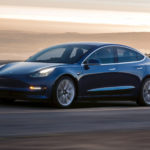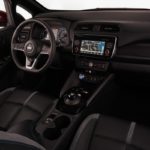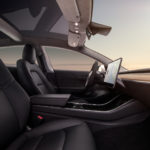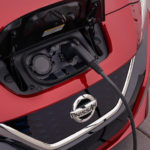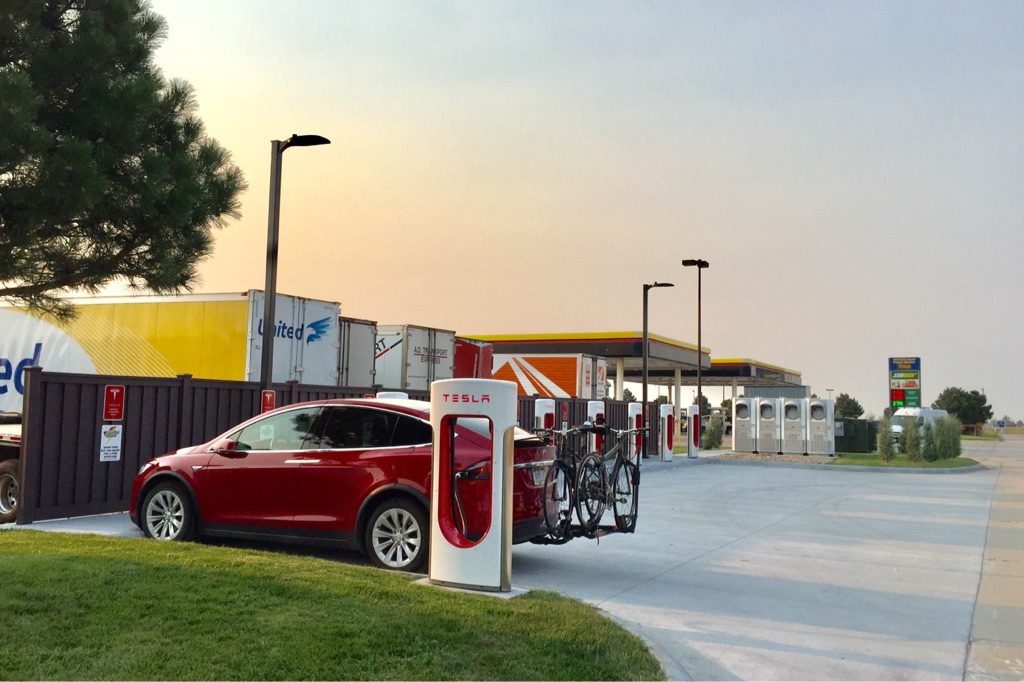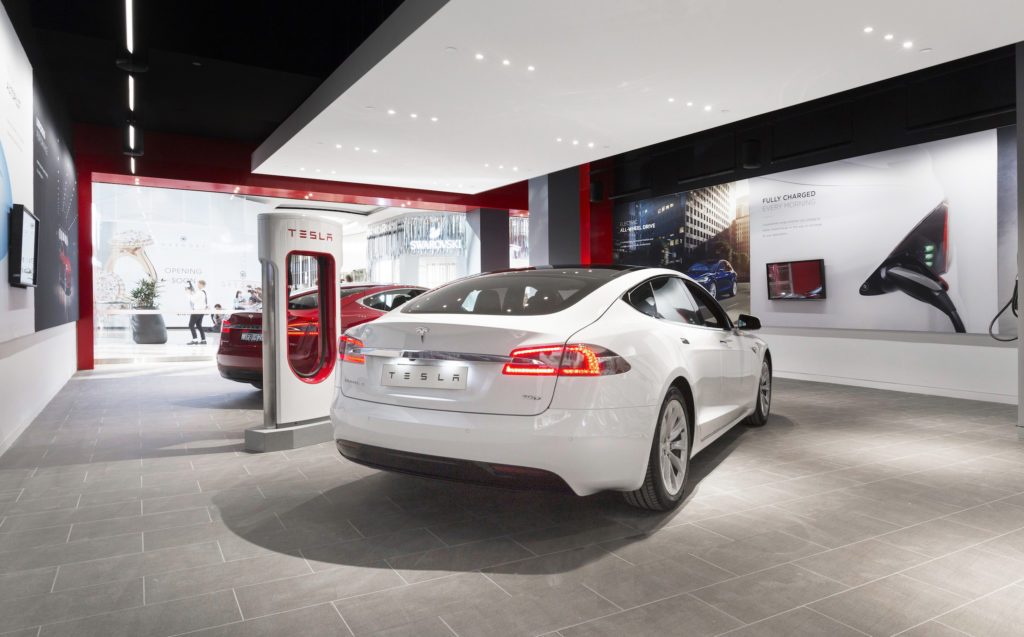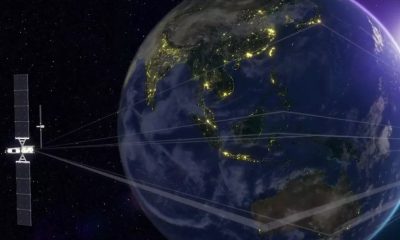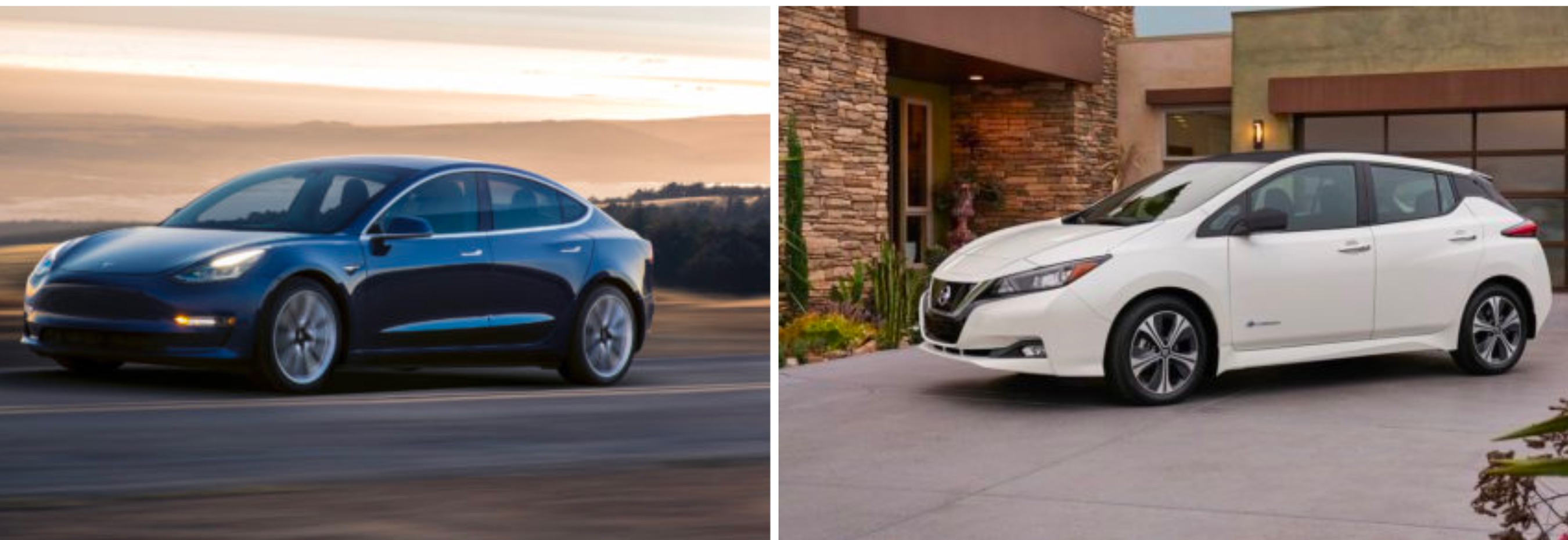

News
Tesla Model 3 vs 2018 Nissan Leaf – A side by side comparison
Tesla’s mission is simple and includes getting other automakers to join in the party. The Chevy Bolt, quirky as it may look, technically beat Tesla to market with a 200+ mile range EV that can be had for the $35,000 ballpark. Nissan, who I humbly believe to be the only other automaker currently taking full EVs seriously, has just announced their all new 2018 Leaf. The party is undoubtedly slow, but other automakers such as Volvo have at least talked about “electrification” (clever marketing shorthand for hybrids) but we can no longer deny that electric vehicles are here and their growth will not be able to be stopped.
Just as every concept EV talked about before 2016 was touted as a “Tesla killer,” it is now impossible not to compare every new electric offering with the much anticipated Tesla Model 3. So let’s do just that. The table below highlights some key specs for each.
| NISSAN LEAF | TESLA MODEL 3 | |
| Base price, before tax credits | $29,990 | $35,000 |
| Price with options | SL – $36,200 | Premium + EAP – $45,000 |
| Range (miles) | 150 (higher coming 2019) | 220 (310 for $9,000 upgrade) |
| Battery | 40 kWh/ (higher coming 2019) | Undisclosed |
| Charge time – Level 2 | Up to 22 miles per hour | Up to 30 miles per hour (std batt) |
| Charge time – Level 3 | Up to 88 miles per ½ hour | Up to 130 miles per ½ hour (std) |
| Charging network | No dedicated network | Tesla Supercharger, pay per use |
| Overall Length/Width | 176.4” / 70.5” | 184.8” / 82.2” |
| Cargo space | 23.6 cf | 15 cf |
| Body style | 4-door hatchback | 4-door sedan |
| Infotainment | Apple CarPlay, Android Auto | Tesla’s own |
| Main display | 7” | 15” |
| 0-60 mph time | 8 seconds (Motor Trend est.) | 5.6 seconds |
| Driver’s Assist Suite | ProPILOT ($2,200) | Autopilot ($5,000) |
| Automatic Emergency Braking | Standard | Standard |
If you want to get into a relatively long range EV (150 miles or greater) for the lowest possible price, the base 2018 Nissan Leaf wins out. I will also assume that you will be able to get your hands on a Leaf much sooner than a Model 3. Finally, if you absolutely insist on a hatchback, the Leaf has it.
Outside of those three things, and possibly the still large size of a Model 3, I can’t personally find any reason to choose a Leaf over a Model 3. To be clear I’m proud of Nissan for upping their game a bit. The 2018 version is in my very humble opinion, far superior in the looks department to the frog-like 2017 it is replacing. Nissan’s V-Motion grille is sharp, and hopefully takes your attention off the obvious charge port cover above it. The lines of the car itself are much more closely aligned with Nissan’s other offerings, which I find to have adequate design. Similarly, the rear tail lights are modern and edgy. If you can excuse all the buttons, the interior looks sharp. The Apple and Android faithful alike will appreciate the available car play integration. The bottom line for me is that every EV is a step in the right direction, even if this car won’t compel families to ditch the gasoline completely. In the absence of a reliable and dedicated fast charging network for long distance travel, the Leaf is still primarily a commuter car. 150 miles of range will simply allow a few after work activities without much thought.
I am excited to see the range and price that Nissan makes available in 2019 because for now, the base cost per mile of $199.93 falls far short of Tesla’s $159.09. I’d also like to see them re-think their battery management system, which I am to understand leaves something to be desired. One owner described his experience with a 2014 Leaf as losing 20% capacity thus far.
When looking at what we know about the Model 3 however, I can’t really compare the Leaf in any serious manner. I’m trying to be reasonable, to give Nissan a fair shake, but there are several things that make me a Tesla fanatic that are sorely missing from the Leaf – and any other current EV for that matter – that may or may not ever come close.
Supercharging. EVs will remain a commuter or secondary car until you can load up the kids and head to Disney with the reasonable assurance that there are plenty of chargers along the way that will a) be working, and b) charge quickly. Tesla has made a huge commitment in this front because they know that’s what it takes.
Over the air updates. I have not yet heard of Nissan taking this approach, but I suspect if they do, it would be limited to maps and small changes. I don’t foresee the Leaf being able to give your car the sudden ability to automatically open your garage four years after you’ve purchased it. Some current automakers do have software updates for their vehicles, but my understanding is that you have to bring it in to the dealership to have it done. This totally defeats the purpose.
Dealerships. You’d be hard pressed to find a harsher critic of dealerships than I. Whether discussing the 2011 Jeep Wrangler that took me 3 hours to get for the exact price I walked in and demanded, or that time I spoke on behalf of a recently widowed neighbor with an actual cash budget who could not, no matter how you pitch it, afford that extended dealer’s warranty package, I can go on and on and about how much I dislike the experience. It always takes hours. You always get passed around from salesperson to manager to finance person. You may even get your credit run 10 times simultaneously (I’m talking to you, Hyundai dealership!) No thank you. I will order my car online, know the exact price and meet you there with a pre-printed check for the exact amount owed.
Looks. I get it, I really do, people love hatchbacks. My Model S is a hatch and has accommodated many a Home Depot trip. My once beloved Scion tC was a hatch, and once hauled 27 boxes of Pergo brand laminate floor planks. Even the Jeep with the horrible dealership experience picked up a washing machine. A washing machine! But I simply cannot wrap my head around the idea that you could conceivably compare the gorgeous, timeless and sleek looks of the Model 3 with the quirky, if a bit modern and sharp, Nissan Leaf.
Performance. There’s a reason I never considered a hybrid or EV before. Now that I’m a bit older and have the budget to pick a car I actually like, I’m not going to voluntarily drive something that takes 8 seconds to get to 60. I want tight steering, good handling, and the ability to make my passengers squeal with delight when I punch it.
Interior. This is a personal preference and I’m with you if you think the minimalistic interior of the Model 3 is crazy. It is. But I can just about promise you that you will not miss all those buttons. I sat in a Porsche Macan at the auto show and while I expected to feel great inside a new offering from a brand with as much clout as Porsche, I was too busy wondering what in the world all those buttons did. It’s almost a joke how many.
Confession: I started this post excited about the new Leaf. I tweeted about it first thing this morning; the more the merrier in EV world if you ask me. But when getting right down to the specifications, it’s hard not to see that everyone else still has a long way to go. They’re taking baby steps while Tesla is competing in the long jump.
What do you think? Do the two cars compare? Tell us in the comments!
Elon Musk
Elon Musk confirms Grok 4 launch on July 9 with livestream event
The rollout will be accompanied by a livestream at 8 p.m. Pacific Time.

Elon Musk has officially confirmed that Grok 4, the latest version of xAI’s large language model, will launch on July 9. The rollout will be accompanied by a livestream at 8 p.m. Pacific Time, hosted on xAI’s official account on X.
xAI goes straight to Grok 4
Back in May, leaks indicated that xAI was getting ready to ship Grok 3.5. Considering Musk’s recent comments, however, it appears that the artificial intelligence startup would be focusing on the large language model’s fourth iteration instead. As noted in a Financial Express report, users on X have sighted references to Grok 4 in the lead up to the update’s launch, such as “grok-4-prod-mimic” and “Grok 4 Code.”
Musk’s Grok 4 announcement comes as AI competition intensifies between major players including OpenAI, Google, and xAI. With Musk’s Colossus supercomputer fully operational in Memphis, xAI appears to be accelerating its AI product roadmap.
Musk pushes Grok toward political neutrality
Grok 4’s launch also follows a recent controversy involving political bias, as noted in a CNN report. Last week, Grok responded to a user on X stating that political violence in the U.S. since 2016 had come more from the political right than the left. The chatbot noted in a later reply that its answer was based on information from sources like Reuters, the Journal of Democracy, and University of Maryland studies.
Musk stated that Grok’s response was a “major fail.” “Major fail, as this is objectively false. Grok is parroting legacy media. Working on it,” he wrote in a post on X. By the end of June, Musk noted that he was “grinding all night with the xAI team” and that they were making “good progress.” He also stated that the model “Will be called Grok 4. Release just after July 4th. Needs one more big run for a specialized coding model.”
News
Tesla opens massive solar Supercharger station in California
The Supercharger opened to customers ahead of Fourth of July weekend, while Tesla continues phase two of construction on the site.

Tesla has officially launched the first several Supercharging posts at a massive station in California, notably including solar canopies and grid-scale batteries to offer completely renewable charging.
Last week, Tesla announced on X that it opened the first 84 Supercharger stalls of a planned 168-stall station in Lost Hills, California. Additionally, the massive Supercharger project features 11MW of solar canopies and 10 Megapack batteries for off-grid charging powered entirely by solar energy.
Tesla completed the first phase of the project just days ahead of the busy Fourth of July holiday weekend, adding that initial construction took just eight months. In addition to the remaining charging stalls, Tesla says it’s building a set of lounge areas, renderings of which can be seen below alongside current photos of the site.
Notably, the site also includes V4 charging posts for the company’s latest available charging speeds, and it’s located near the busy junction between I-5 and Highway 46 in Kern County.
“Thank you [Kern County] and [PG&E] for collaboration and approvals,” Tesla wrote in a follow-up post.

Credit: Tesla Charging | X

Credit: Tesla Charging | X

Credit: Tesla Charging | X

Credit: Tesla Charging | X
Tesla Supercharger Maps for North America, Europe, and Asia pic.twitter.com/0U5r0XRPyo
— TESLARATI (@Teslarati) July 2, 2025
READ MORE ON TESLA SUPERCHARGERS: Tesla launches ultra-fast V4 Superchargers in China for the first time
Testing at the LA Diner, plus Musk update on potential Tesla solar Gigafactory
The huge Tesla Supercharger station completed phase one of construction fairly quickly, especially given how long Tesla has been working on its unique Los Angeles diner, drive-in, and Supercharger location. Still, the company was seen performing some testing at the nearly-completed charging station earlier this month, and will reportedly be holding a job fair.
Elon Musk also responded on Monday morning to a post on X, suggesting that Tesla is “thinking about” building a U.S.-based solar Gigafactory in order to help support increased power needs with AI growth, and to bolster domestic solar production.
Tesla is building a new UFO-inspired Supercharger in the heart of Alien country
News
Tesla driver walks away from major accident with minor injuries
The driver sustained only minor injuries, and the exact cause of the crash remains under investigation.

The driver of a Tesla Model Y survived and walked away from a harrowing accident on Monday in California, only sustaining minor injuries despite the vehicle being impaled by a guardrail.
On Monday morning around 4:34 a.m., the Los Banos division of the California Highway Patrol (CHP) responded to the accident on I-5 near Panoche Road, involving a 23-year-old in a Tesla Model Y. According to a post on social media, the driver veered off the road for unknown reasons in the northbound lane, before crashing directly into the guardrail and impaling the vehicle.
You can read the full message and photos from Los Banos CHP below, as were shared in a Facebook post on Monday afternoon.
This morning a Tesla model y was traveling in the #1 northbound lane of I-5 north of Panoche Rd. For unknown reasons driver allowed V-1 to veer off the roadway, travel through a dirt center divide, and crashed into the fixed metal guardrail. Lucky for the driver he only sustained minor injuries and was able to walk away. Driving a vehicle requires 100% attention to the road. Avoid distractions and focus on driving.

Credit: CHP Los Banos (via Facebook)

Credit: CHP Los Banos (via Facebook)

Credit: CHP Los Banos (via Facebook)
In a statement to SFGate, CHP officer Myles Anderson said that the driver only sustained minor injuries, while no arrests are made and drugs and alcohol are not suspected to have been involved. The report also notes that Tesla’s “cruise control and lane assistance features” were activated, according to Anderson. However, it’s not entirely clear if this is referring to Supervised Full Self-Driving (FSD), or to the cruise control and lane assist features baked into Autopilot.
At the time of writing, CHP has not yet responded to Teslarati’s request for clarification and additional details on the matter.
Tesla Crash Safety Ratings across its lineup: pic.twitter.com/ny30R7ceji
— TESLARATI (@Teslarati) July 1, 2025
READ MORE ON TESLA SAFETY: Tesla rolls out crucial new safety feature aimed at saving children
The news comes after Tesla has touted its vehicles as incredibly safe for many years. In December, for example, the company highlighted receiving top safety scores from regulators on four different continents throughout the world, including from the National Highway Traffic Safety Administration (NHTSA) and the Insurance Institute of Highway Safety (IIHS) in the U.S.
Tesla has also listed the goal of making its vehicles the safest on the road throughout the years, both in the overall design of its vehicles and in its Autopilot and Full Self-Driving (FSD) programs.
Tesla Model 3 ranks as the safest new car in Europe for 2025, per Euro NCAP tests
-

 Elon Musk1 week ago
Elon Musk1 week agoTesla investors will be shocked by Jim Cramer’s latest assessment
-

 News2 weeks ago
News2 weeks agoTesla Robotaxi’s biggest challenge seems to be this one thing
-

 News2 weeks ago
News2 weeks agoWatch the first true Tesla Robotaxi intervention by safety monitor
-

 Elon Musk2 weeks ago
Elon Musk2 weeks agoA Tesla just delivered itself to a customer autonomously, Elon Musk confirms
-

 News2 weeks ago
News2 weeks agoTesla Robotaxi rollout proves that Elon Musk still delivers, even if it’s late
-

 Elon Musk2 weeks ago
Elon Musk2 weeks agoxAI welcomes Memphis pollution results, environmental groups push back
-

 Elon Musk2 weeks ago
Elon Musk2 weeks agoElon Musk commends Tesla team on successful Robotaxi launch
-

 Elon Musk2 weeks ago
Elon Musk2 weeks agoElon Musk confirms Tesla Optimus V3 already uses Grok voice AI


